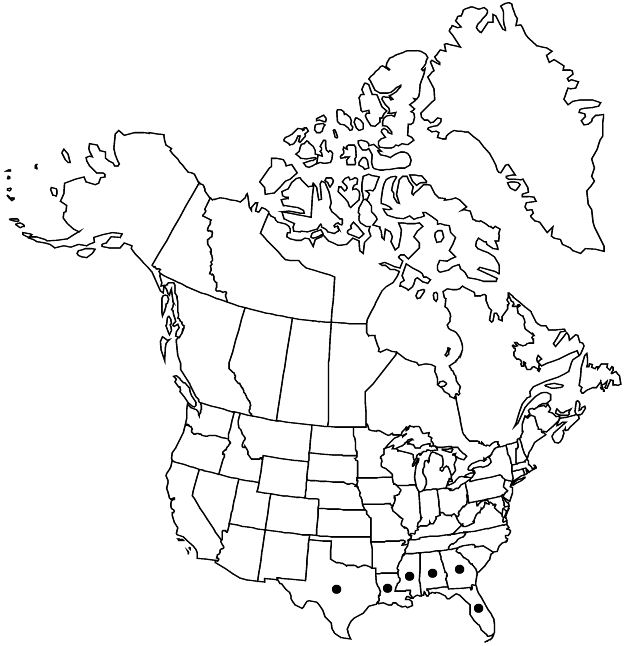Difference between revisions of "Euphorbia discoidalis"
Fl. South. U.S., 401. 1860.
FNA>Volume Importer |
imported>Volume Importer |
||
| (6 intermediate revisions by 2 users not shown) | |||
| Line 16: | Line 16: | ||
|name=Tithymalopsis discoidalis | |name=Tithymalopsis discoidalis | ||
|authority=(Chapman) Small | |authority=(Chapman) Small | ||
| + | |rank=species | ||
}} | }} | ||
|hierarchy=Euphorbiaceae;Euphorbia;Euphorbia sect. Alectoroctonum;Euphorbia discoidalis | |hierarchy=Euphorbiaceae;Euphorbia;Euphorbia sect. Alectoroctonum;Euphorbia discoidalis | ||
| Line 31: | Line 32: | ||
|elevation=0–150 m. | |elevation=0–150 m. | ||
|distribution=Ala.;Fla.;Ga.;La.;Miss.;Tex. | |distribution=Ala.;Fla.;Ga.;La.;Miss.;Tex. | ||
| − | |discussion=<p>M. J. Huft (1979) remarked that Euphorbia discoidalis is uncommon west of Alabama and referred many narrow-leaved specimens from Louisiana and Texas to E. corollata. K. R. Park (1998) included them in an expanded E. discoidalis, and that is followed here. The western populations can be distinguished from E. corollata by their shorter involucral gland appendages and revolute leaf margins. Further study of these western populations is warranted.</p> | + | |discussion=<p>M. J. Huft (1979) remarked that <i>Euphorbia discoidalis</i> is uncommon west of Alabama and referred many narrow-leaved specimens from Louisiana and Texas to <i>E. corollata</i>. K. R. Park (1998) included them in an expanded <i>E. discoidalis</i>, and that is followed here. The western populations can be distinguished from <i>E. corollata</i> by their shorter involucral gland appendages and revolute leaf margins. Further study of these western populations is warranted.</p> |
|tables= | |tables= | ||
|references= | |references= | ||
| Line 40: | Line 41: | ||
-->{{#Taxon: | -->{{#Taxon: | ||
name=Euphorbia discoidalis | name=Euphorbia discoidalis | ||
| − | |||
|authority=Chapman | |authority=Chapman | ||
|rank=species | |rank=species | ||
| Line 55: | Line 55: | ||
|publication year=1860 | |publication year=1860 | ||
|special status=Endemic | |special status=Endemic | ||
| − | |source xml=https:// | + | |source xml=https://bitbucket.org/aafc-mbb/fna-data-curation/src/2e0870ddd59836b60bcf96646a41e87ea5a5943a/coarse_grained_fna_xml/V12/V12_464.xml |
|genus=Euphorbia | |genus=Euphorbia | ||
|section=Euphorbia sect. Alectoroctonum | |section=Euphorbia sect. Alectoroctonum | ||
Latest revision as of 19:15, 5 November 2020
Herbs, perennial, with spreading rootstock. Stems erect or ascending, unbranched, solitary or few, previous year's dead stems not persistent, 45–70 cm, usually densely puberulent to sericeous, rarely glabrous. Leaves alternate; stipules to 0.1 mm; petiole (0–)1–2 mm (or absent), densely puberulent; blade usually linear, rarely ovate, 25–55 × 1.5–4 mm, base cuneate, margins entire, revolute, apex rounded, abaxial surface glabrous or puberulent to sericeous, adaxial surface glabrous; venation often obscure on smaller leaves, midvein conspicuous. Cyathia in terminal pleiochasia; peduncle 5–15 mm, filiform, glabrous or very sparsely puberulent to sericeous. Involucre campanulate, 1.2–1.4 × 1.2–2 mm, sparsely to densely puberulent; glands 5, green, reniform, 0.2–0.3 × 0.5–0.6 mm; appendages white, orbiculate to oblong, (0.5–)1–1.7 × 1–1.5 mm, entire. Staminate flowers 20–25. Pistillate flowers: ovary glabrous or sparsely strigose; styles 0.5–1.1 mm, 2-fid at apex to 1/2 length. Capsules globose, 1.8–3 × 2.5–4.8 mm, glabrous or sparsely strigose; columella 2.3–2.5 mm. Seeds light gray, ovoid, 2 × 1.2–1.3 mm, smooth or with few, very shallow depressions; caruncle absent.
Phenology: Flowering and fruiting late spring–fall.
Habitat: Sand hills, pine savannas, woodland borders, open fields with sandy soils.
Elevation: 0–150 m.
Distribution

Ala., Fla., Ga., La., Miss., Tex.
Discussion
M. J. Huft (1979) remarked that Euphorbia discoidalis is uncommon west of Alabama and referred many narrow-leaved specimens from Louisiana and Texas to E. corollata. K. R. Park (1998) included them in an expanded E. discoidalis, and that is followed here. The western populations can be distinguished from E. corollata by their shorter involucral gland appendages and revolute leaf margins. Further study of these western populations is warranted.
Selected References
None.